Travel - by air - by sea - on ice.
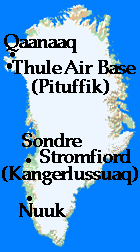 The gateway to the northern and middle part of Greenland is the airport Sondre Stromfiord (Kangerlussuaq). Almost everyday planes from Denmark, Iceland or Canada land here.
The gateway to the northern and middle part of Greenland is the airport Sondre Stromfiord (Kangerlussuaq). Almost everyday planes from Denmark, Iceland or Canada land here.
Qaanaaq and Pituffik (Thule Air Base) are serviced once a week with a flight from Kangerlussuaq.

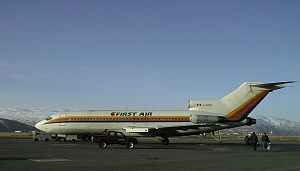 Canadian First Air provides service from Kangerlussuaq to the
Thule Air Base. These weekly flights include supplies to the American
base, so normally there will be seats for only 54 passengers.
The route from Kangerlussuaq to Thule Air Base is almost straight north
and is about 1 hour and 40 minutes travel time. On this flight there will be
a great opportunity to see the northern part of the Greenland
west coast - with thousands of icebergs and glaciers - the Disko
Island - the Uummannaq Fiord - and of course the Melville Bay before
landing on Thule Air Base (Pituffik).
Canadian First Air provides service from Kangerlussuaq to the
Thule Air Base. These weekly flights include supplies to the American
base, so normally there will be seats for only 54 passengers.
The route from Kangerlussuaq to Thule Air Base is almost straight north
and is about 1 hour and 40 minutes travel time. On this flight there will be
a great opportunity to see the northern part of the Greenland
west coast - with thousands of icebergs and glaciers - the Disko
Island - the Uummannaq Fiord - and of course the Melville Bay before
landing on Thule Air Base (Pituffik).
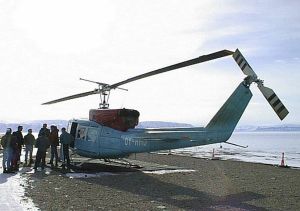 From Pituffik, Qaanaaq and the settlements are serviced by Greenlandair Charter's
small Bell 212 helicopter with seats for 8 passengers.
In the summer half year, settlements are usually serviced once or twice
a week. In the winter half year, during total darkness, helicopter
flying is more difficult so usually there will be only scheduled
flights to the settlements twice every second week.
From Pituffik, Qaanaaq and the settlements are serviced by Greenlandair Charter's
small Bell 212 helicopter with seats for 8 passengers.
In the summer half year, settlements are usually serviced once or twice
a week. In the winter half year, during total darkness, helicopter
flying is more difficult so usually there will be only scheduled
flights to the settlements twice every second week.
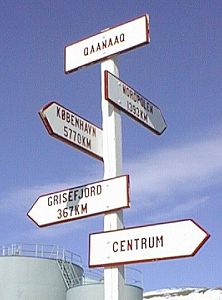 In Qaanaaq there is a short private airstrip for smaller airplanes like DeHavilland turbo-prop Twin Otter (the
work horse airplane of the Polar regions). It is usually possible to get fuel if
agreed to in advance. In summer and spring, Twin Otters often land here bringing in passengers and tourists directly from Canada. This same traffic
is frequent in the spring, but then planes will normally land on an air
strip marked with barrels on sea ice right outside Qaanaaq.
In Qaanaaq there is a short private airstrip for smaller airplanes like DeHavilland turbo-prop Twin Otter (the
work horse airplane of the Polar regions). It is usually possible to get fuel if
agreed to in advance. In summer and spring, Twin Otters often land here bringing in passengers and tourists directly from Canada. This same traffic
is frequent in the spring, but then planes will normally land on an air
strip marked with barrels on sea ice right outside Qaanaaq.
In summer 1998 the construction of a new modern airfield near Qaanaaq
started up. If not delayed, the airfield, which is about 2640 feet (800 meters)
long, will be put in use in the fall of year 2000. This hopefully
will lead to improved access and better possibilities for access to the area for both tourists and locals.
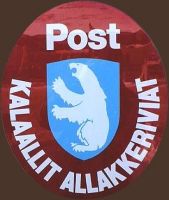 Since there is only one weekly flight carrying mail from the "outside" to the Thule Air Base, this of course allows mail delivery only once a week.
However in winter, when the weather "grounds" helicopter flights,
mail delivery may be delayed for a week or more.
Since there is only one weekly flight carrying mail from the "outside" to the Thule Air Base, this of course allows mail delivery only once a week.
However in winter, when the weather "grounds" helicopter flights,
mail delivery may be delayed for a week or more.
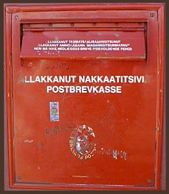 Because of the unstable mail deliveries, high tech communications
are well developed and very used. Telephone, fax and Internet are fully
functional at any time.
Because of the unstable mail deliveries, high tech communications
are well developed and very used. Telephone, fax and Internet are fully
functional at any time.
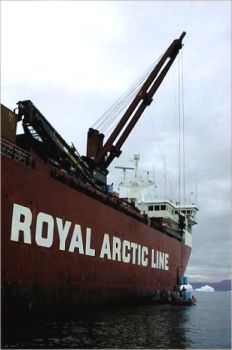 Most heavy freight is usually delivered by ship. The first ship
of the year normally arrives at Qaanaaq about the 1st of August.
The last ship will usually leave southbound in the middle of September.
Two or three ships bring in heavy supplies and machines for construction
and all kinds of supplies needed to be stored for the next ten months until the
ships return again the following summer.
Most heavy freight is usually delivered by ship. The first ship
of the year normally arrives at Qaanaaq about the 1st of August.
The last ship will usually leave southbound in the middle of September.
Two or three ships bring in heavy supplies and machines for construction
and all kinds of supplies needed to be stored for the next ten months until the
ships return again the following summer.
There is no seaport in Qaanaaq so the handling of ships sometimes
is very slow and difficult because of the current and icebergs. The loading
and unloading of ships is done with a motorized barge (like the ones for
military use) and only in fair weather. Because of a long reef just
outside Qaanaaq it is only possibly to work when the tide is high.
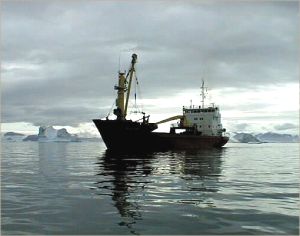 The settlements are supplied by smaller ships. Also a tanker shows
up once a year in Qaanaaq and the surrounding settlements. Tanks
and barrels will be filled up with different kinds of fuel to stand through
the long winter.
The settlements are supplied by smaller ships. Also a tanker shows
up once a year in Qaanaaq and the surrounding settlements. Tanks
and barrels will be filled up with different kinds of fuel to stand through
the long winter.
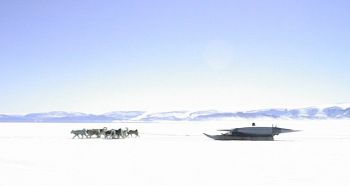 In the district
of Qaanaaq the dogsledge is still very important for transportation For
tourists, or anyone else with the time to do it, dogsledging is highly recommended. Besides just being transported from one place to another, you will
have an unforgettable adventure in experiencing nature together with the
Inuit drivers. One day trips or longer tours with overnights in huts
or in tents on the sledge can be arranged through the hotel in Qaanaaq.
In the district
of Qaanaaq the dogsledge is still very important for transportation For
tourists, or anyone else with the time to do it, dogsledging is highly recommended. Besides just being transported from one place to another, you will
have an unforgettable adventure in experiencing nature together with the
Inuit drivers. One day trips or longer tours with overnights in huts
or in tents on the sledge can be arranged through the hotel in Qaanaaq.
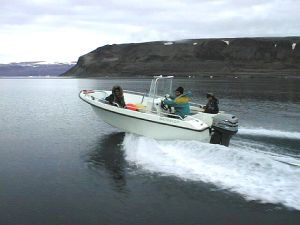 In summer
from the end of July until the beginning of October no permanent ice is covering the sea. At this time small fast boats with outboard engines are used for transportation. The small boats are fast but of course only used when weather is good and the sea is calm. Trips by boats can also be arranged by contacting the
hotel in Qaanaaq.
In summer
from the end of July until the beginning of October no permanent ice is covering the sea. At this time small fast boats with outboard engines are used for transportation. The small boats are fast but of course only used when weather is good and the sea is calm. Trips by boats can also be arranged by contacting the
hotel in Qaanaaq.

Back
to Directory
Counter for statistical purposes and may be reset: 

 Canadian First Air provides service from Kangerlussuaq to the
Thule Air Base. These weekly flights include supplies to the American
base, so normally there will be seats for only 54 passengers.
The route from Kangerlussuaq to Thule Air Base is almost straight north
and is about 1 hour and 40 minutes travel time. On this flight there will be
a great opportunity to see the northern part of the Greenland
west coast - with thousands of icebergs and glaciers - the Disko
Island - the Uummannaq Fiord - and of course the Melville Bay before
landing on Thule Air Base (Pituffik).
Canadian First Air provides service from Kangerlussuaq to the
Thule Air Base. These weekly flights include supplies to the American
base, so normally there will be seats for only 54 passengers.
The route from Kangerlussuaq to Thule Air Base is almost straight north
and is about 1 hour and 40 minutes travel time. On this flight there will be
a great opportunity to see the northern part of the Greenland
west coast - with thousands of icebergs and glaciers - the Disko
Island - the Uummannaq Fiord - and of course the Melville Bay before
landing on Thule Air Base (Pituffik).
 The gateway to the northern and middle part of Greenland is the airport Sondre Stromfiord (Kangerlussuaq). Almost everyday planes from Denmark, Iceland or Canada land here.
The gateway to the northern and middle part of Greenland is the airport Sondre Stromfiord (Kangerlussuaq). Almost everyday planes from Denmark, Iceland or Canada land here.







